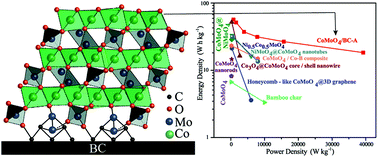CoMoO4/bamboo charcoal hybrid material for high-energy-density and high cycling stability supercapacitors
Abstract
Here we report a supercapacitor with high energy density and high cycling stability using low-cost and environmentally friendly CoMoO4/bamboo charcoal (BC) hybrid materials as the cathode. The hybrid materials were fabricated via a one-pot solvothermal reaction followed by an annealing process. The optimized CoMoO4/BC hybrid material has a specific surface area of 74.4 m2 g−1, being 1.7-fold higher than that of the CoMoO4 precursor. The hybrid electrode shows a high specific capacitance of 422.3 F g−1 at 0.5 A g−1 and 304.8 F g−1 at 50 A g−1. The as-assembled CoMoO4/BC||activated carbon supercapacitor exhibits a high energy density of 56.7 W h kg−1 and 18.3 W h kg−1 at a power density of 785 W kg−1 and 40 000 W kg−1, respectively. Furthermore, it also shows excellent long-term cycling stability. Subjected to 40 000 cycles of charge–discharge test at a current density of 50 A g−1, there is only about 10% capacitance loss (occurring only during the first 5000 cycles). This excellent electrochemical performance is ascribed to the covalent C–Mo and C–O bonds formed between CoMoO4 and BC as well as the porous feature of the hybrid material, which provide highways for electron transfer and ion transportation within the electrodes and at the electrode–electrolyte interface.



 Please wait while we load your content...
Please wait while we load your content...